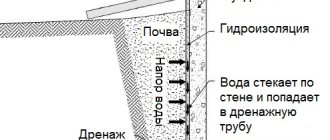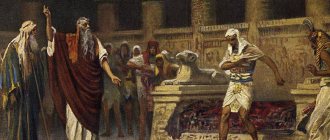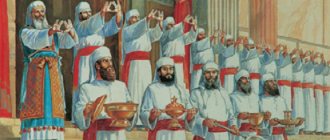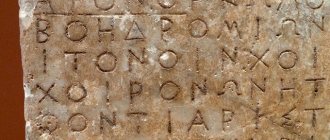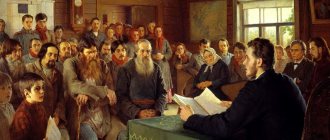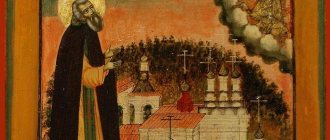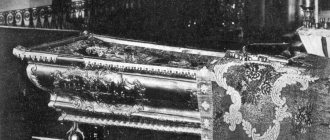Biblical miracle
According to the Bible, in the 13th century BC, the founder of the religion of Judaism, Moses, who managed to unite all the Israeli tribes into a single people, received a command from God to lead his fellow tribesmen out of Egypt. By that time, the Israelis had been under the rule of Pharaoh Ramesses II for decades, a talented and cruel commander who desperately sought to restore Egypt's former greatness by conquering Asia. To this end, he invaded the land of Goshen, located in the Nile Delta, where Israeli tribes had lived for several centuries, and on the captured territory he built the cities of Pithom and Raamses, which became a strategic springboard for the pharaoh in the decisive push to the east. From that time on, the long period of Israeli slavery and persecution by the Egyptian authorities against a large but scattered people began, colorfully described in the Old Testament. After numerous miracles performed by Moses, which angered the hard-hearted Pharaoh, and the “plagues of Egypt,” 45 thousand Israelis with livestock and household belongings left Egypt. Having learned about the flight of the conquered people, Ramesses II, together with his army, set off in pursuit of the Israelis and overtook them near the shore of the Red Sea. Having learned about the approach of his pursuers, Moses “cut” the waters with the help of a magic rod. Along the exposed bottom, the Israelis safely crossed to the opposite bank. When Pharaoh's chariots drove into the passage formed between the seething walls of water, Moses extended his hands - and in the blink of an eye the sea closed over the heads of the enemies.
Jews approach the sea [↑]
The book of the Pentateuch of Shemot tells how the Jews came out of Egypt, punished for their enslavement with ten plagues, and approached the sea. As they set up camp, they saw an army of Egyptians approaching them. In great fear, the Jews began to cry out to G‑d and reproach their leader Moses (Moshe) for leading them out of Egypt ( Shemot 14:10-12
).
Moses answered them: “Do not be afraid. Stand and see the salvation that the Lord has sent down, which He will bring to you today; for as you have seen the Egyptians today, you will see them no more forever. The Lord will fight the battle for you and will fight the battle for you
.
For you, for you. And similarly (to this) “for the Lord fights the battle for them להם” [14, 25], and also “for the G-d ל - לא will you fight” [Job 13, 8], and also “and who spoke לי about me (for my sake)” [At the beginning 24, 7], and also “should you fight for the baal לבעל” [Judges 6, 31], and you remain silent” ( Shemot 14:13-14
).
The Midrash explains this passage of the Torah this way: from Moshe’s words it follows that the Jewish people were divided into four groups. Representatives of the tribes of Reuven, Shimon and Issachar succumbed to panic and decided that they would rather throw themselves into the sea than confront the Egyptians. Moshe reassured them: “Don’t be afraid, be calm, and you will see that the Almighty will save you!” The tribes of Zebulun, Benjamin, and Naphtali believed it was best to surrender and return to Egypt. “You will never see the Egyptians again,” Moshe promised. The tribes of Judah and Yosef exclaimed: “Let us march out and engage the Egyptians in battle.” But Moshe corrected them: “Hashem will fight for you.” The tribes of Dan, Gad, and Asher proposed to raid the Egyptian camp and cause panic there.
“No,” Moshe replied. “Stay here and abandon this plan.”
The vagaries of the weather
For thousands of years, the event described in the Bible for followers of Judaism, and later for Christians, was another proof of the limitless power of the Almighty, who performed a miracle. However, in the second half of the 20th century, English climate scientists, drawing attention to the biblical description of the wind that blew all night over the Red Sea, suggested that it was a powerful air flow that could influence the water level and thus contribute to the successful crossing of the Israelites. Already in this century, scientists from the St. Petersburg branch of the Institute of Oceanology of the Russian Academy of Sciences, developing the hypothesis of their English colleagues, stated that the passage of Moses described in the Bible could have occurred in the area of the Gulf of Suez, separating Africa from the Sinai Peninsula. It is in this place, at a depth of seven meters, that there is a transverse reef, which in biblical times was most likely four meters higher. Mathematical calculations of the situation described in the Old Testament showed that in the event of a coincidence of such natural and climatic phenomena as low tide and hurricane winds, the speed of which should be at least 35-40 meters per second, the water level in the reef area can drop significantly within a few hours . As a result of this, there is a real possibility of draining the reef shoal, up to four kilometers wide, which is where the Israelis could have walked. The heavy chariots of the Egyptians who were catching up with them got stuck in the muddy bottom, after which a powerful return wave of the tide hit them, swallowing up the invincible army. However, such a coincidence of circumstances, according to scientists, happens extremely rarely, approximately once every 50 thousand years. And the fact that Moses and his fellow tribesmen found themselves on the seashore at that very time can, without exaggeration, be called a miracle.
Arrival in Egypt and the miracles of Moses
Prophet Musa, having arrived in Egypt, tried to encourage Pharaoh to believe in Allah Almighty, showing him a variety of miracles, one of which was the miracle when the staff turned into a snake, and the hand of the Prophet Moses turned white after he took it out of his clothes. Pharaoh ordered to convene all the best sorcerers of Egypt, arrogantly declaring that the miracles of the prophet Musa were nothing more than witchcraft.
The sorcerers, having gathered with the pharaoh, asked him for a reward for themselves after they won the competition with Musa and received confirmation from the pharaoh, moreover, he promised to make them his close people. But the witchcraft that the Egyptian sorcerers tried to perform was dispelled, and the staff thrown by the prophet Musa and turned into a snake absorbed all the illusory snakes of the sorcerers. Having seen such a miracle, the sorcerers themselves realized the truth and immediately accepted the religion of the prophet Moses, falling on their faces and repenting of their witchcraft: “ The sorcerers fell on their faces and said: “We have believed in the Lord Harun (Aaron) and Musa (Moses)! "(Sura Ta Ha, verse 70).
As a result of Musa's prophetic mission, many believed in Allah, even Pharaoh's wife, but Pharaoh himself did not believe and began to persecute Musa and his fellow believers. God, as punishment, sent various disasters to Egypt, and then Pharaoh got scared and promised that he would release Moses, as well as his people, and allow them to leave Egypt, but the ruler did not keep his word.
Historians' mistake
At the same time, American scientists Carl Druce and Weiqing Han, without questioning the reality of the events that occurred 33 centuries ago in the Middle East, believe that even a very strong east wind was not able to drain such a vast area of deep-sea waters. Moreover, they made the bold assumption that numerous Bible scholars and Israeli historians were mistaken in mistaking the Old Testament Red Sea for the Red Sea. Translated from Church Slavonic, as well as from English, the Red Sea, or Red Sea, has another name - the Sea of Reeds. The Hebrew name for the sea that the Israelites crossed is also translated - Yam-Suf. However, reeds never grew in the Red Sea area. Based on this, American scientists invited the scientific community to discuss the hypothesis that Moses made his famous journey not across the sea, but through a lake, which in Old Testament times was located near the ancient city of Tanis in the eastern part of the Nile Delta. Nowadays this lake is called Menzala, and its shores abound with thickets of reeds. A thorough analysis of ancient maps and archaeological data, as well as computer modeling, allowed researchers to claim that such a miracle could have happened to the Israeli people on the shallow and overgrown Lake Menzala, the waters of which could well have been dispersed by a strong and prolonged wind. The research results were published, causing a mixed reaction from readers and a whole series of new, sometimes the most fantastic options for explaining the biblical miracle.
Prophet Musa and Prophet Muhammad ﷺ
The life story of the Prophet Musa most closely resembles the life of the Prophet Muhammad ﷺ, who was also the leader of his community and made all his efforts to convert the Arab pagans in Mecca to monotheism.
The Holy Book of the Koran, telling the story of the life of Musa, draws parallels with the history of the prophetic mission of Muhammad ﷺ: Pharaoh did not want to listen to Musa, and the Meccans did not want to listen to Muhammad ﷺ. Like Prophet Muhammad ﷺ, Prophet Musa brought into the world the great law of God, which was revealed to him on Mount Sinai.
For Muslims, Musa is a revered and great Prophet, the true bearer of the prophetic mission. From the history of Prophet Musa and his people, Muslims take many useful examples and instructions, which are given both in the Holy Quran and in the hadiths of the Prophet Muhammad ﷺ.
Incredible hypotheses
Thus, in particular, the Israeli geologist Yehudi Menachem stated in 2005 that the exposure of the bottom of the Red Sea during Moses' crossing was associated with a strong earthquake that occurred on the Arabian Peninsula in the second half of the 13th century BC. The earthquake caused a rapid ebb of water into the Gulf of Aden, and then turned into a destructive tsunami, which most likely destroyed the pharaoh's army. American orientalist David Warren, after analyzing Chinese chronicles of that period, suggested that the legendary waste of water was caused by the gravitational forces of a large comet then seen in the sky. He is echoed by the English researcher Charles Masterson, who in 2009 stated that the biblical miracle was caused by... the planet Nibi-ru, which approached the Earth at a minimum distance that day. According to Masterson, the negative impact of the space guest also explains the famous “Egyptian executions” that befell the subjects of Ramesses II. No less interesting is the version of the British UFO Society, according to whose members, the exposure of the bottom was caused by the influence of... an alien ship. This hypothesis, according to ufologists, is confirmed in a number of ancient Egyptian sources; it is also reflected in later Roman chronicles, which mention a fiery chariot that overshadowed from the sky the path of ships heading to the ports of the Red Sea. The Bible also indirectly mentions this, indicating that the path for Moses on his dangerous journey was illuminated by a bright cloud, supposedly sent by the god Yahweh. Today, many question the reality of the events described in biblical sources. And this is not surprising, because it is difficult for a modern person to imagine how limitless and inexplicable the influence of higher powers can be, the existence of which was well known to people of previous historical eras.
Magazine: Secrets of the 20th century No. 28, July 2012 Category: Myth and reality Author: Sergey Kozhushko
Tags: Ancient Egypt, Secrets of the 20th century, water, sea, bible, hypothesis, Red Sea, Jews, exodus, Moses
- Back
- Forward
What happened to the pharaoh? [↑]
According to one version, when his army was drowning, he survived to witness the triumph of the Jews. And only then did he also die at sea. According to another version, he survived, but never returned to Egypt. He lived in exile, proclaiming the greatness of G-d.
Pirkei de Rabi Eliezer
points to Pharaoh as a living example of the great power of repentance. When Pharaoh was thrown into the sea, he recognized the truth of the power of the Most High, which he had denied in the past. Therefore, the Almighty saved him, and he fled to Ninwei, where he became king. It was to him that the prophet Jonah was sent much later, calling the inhabitants of the city to repentance, and he listened to the words of the prophet.

